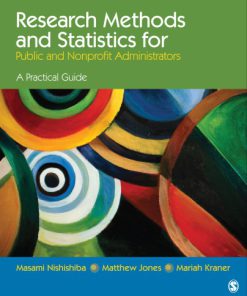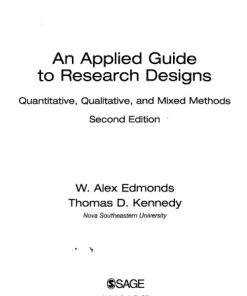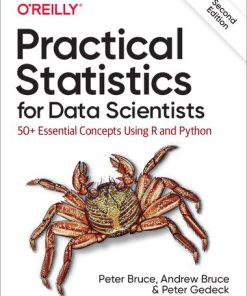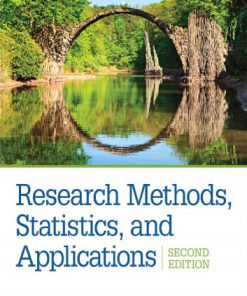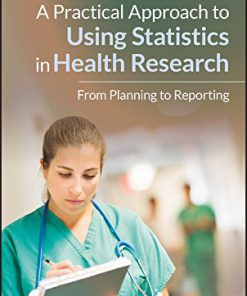Quantitative methods for health research a practical interactive guide to epidemiology and statistics 2nd Edition by Nigel Bruce, Daniel Pope, Debbi Stanistreet ISBN 1118665406 978-1118665404
$50.00 Original price was: $50.00.$25.00Current price is: $25.00.
Quantitative methods for health research a practical interactive guide to epidemiology and statistics 2nd Edition by Nigel Bruce, Daniel Pope, Debbi Stanistreet – Ebook PDF Instant Download/Delivery: 1118665406, 978- 1118665404
Full download Quantitative methods for health research a practical interactive guide to epidemiology and statistics 2nd Edition after payment
Product details:
ISBN 10: 1118665406
ISBN 13: 978-1118665404
Author: Nigel Bruce, Daniel Pope, Debbi Stanistreet
A practical introduction to epidemiology, biostatistics, and research methodology for the whole health care community
This comprehensive text, which has been extensively revised with new material and additional topics, utilizes a practical slant to introduce health professionals and students to epidemiology, biostatistics, and research methodology. It draws examples from a wide range of topics, covering all of the main contemporary health research methods, including survival analysis, Cox regression, and systematic reviews and meta-analysis–the explanation of which go beyond introductory concepts. This second edition of Quantitative Methods for Health Research: A Practical Interactive Guide to Epidemiology and Statistics also helps develop critical skills that will prepare students to move on to more advanced and specialized methods.
A clear distinction is made between knowledge and concepts that all students should ensure they understand, and those that can be pursued further by those who wish to do so. Self-assessment exercises throughout the text help students explore and reflect on their understanding. A program of practical exercises in SPSS (using a prepared data set) helps to consolidate the theory and develop skills and confidence in data handling, analysis, and interpretation. Highlights of the book include:
- Combining epidemiology and bio-statistics to demonstrate the relevance and strength of statistical methods
- Emphasis on the interpretation of statistics using examples from a variety of public health and health care situations to stress relevance and application
- Use of concepts related to examples of published research to show the application of methods and balance between ideals and the realities of research in practice
- Integration of practical data analysis exercises to develop skills and confidence
- Supplementation by a student companion website which provides guidance on data handling in SPSS and study data sets as referred to in the text
Quantitative Methods for Health Research, Second Edition is a practical learning resource for students, practitioners and researchers in public health, health care and related disciplines, providing both a course book and a useful introductory reference.
Quantitative methods for health research a practical interactive guide to epidemiology and statistics 2nd Table of contents:
-
Introduction and Learning Objectives
- 1.1 Approaches to Scientific Research
- 1.2 Formulating a Research Question
- 1.3 Rates: Incidence and Prevalence
- 1.4 Concepts of Prevention
- 1.5 Answers to Self-Assessment Exercises
-
Routine Data Sources and Descriptive Epidemiology
- 2.1 Routine Collection of Health Information
- 2.2 Descriptive Epidemiology
- 2.3 Information on the Environment
- 2.4 Displaying, Describing, and Presenting Data
- 2.5 Routinely Available Health Data
- 2.6 Descriptive Epidemiology in Action
- 2.7 Overview of Epidemiological Study Designs
- 2.8 Answers to Self-Assessment Exercises
-
Standardisation
- 3.1 Health Inequalities in Merseyside
- 3.2 Indirect Standardisation: Calculation of the Standardised Mortality Ratio (SMR)
- 3.3 Direct Standardisation
- 3.4 Standardisation for Factors Other Than Age
- 3.5 Answers to Self-Assessment Exercises
-
Surveys
- 4.1 Purpose and Context
- 4.2 Sampling Methods
- 4.3 The Sampling Frame
- 4.4 Sampling Error, Confidence Intervals, and Sample Size
- 4.5 Response
- 4.6 Measurement
- 4.7 Data Types and Presentation
- 4.8 Answers to Self-Assessment Exercises
-
Cohort Studies
- 5.1 Why Do a Cohort Study?
- 5.2 Obtaining the Sample
- 5.3 Measurement
- 5.4 Follow-Up
- 5.5 Basic Presentation and Analysis of Results
- 5.6 How Large Should a Cohort Study Be?
- 5.7 Assessing Whether an Association is Causal
- 5.8 Simple Linear Regression
- 5.9 Introduction to Multiple Linear Regression
- 5.10 Answers to Self-Assessment Exercises
-
Case–Control Studies
- 6.1 Why Do a Case–Control Study?
- 6.2 Key Elements of Study Design
- 6.3 Basic Unmatched and Matched Analysis
- 6.4 Sample Size for a Case–Control Study
- 6.5 Confounding and Logistic Regression
- 6.6 Answers to Self-Assessment Exercises
-
Intervention Studies
- 7.1 Why Do an Intervention Study?
- 7.2 Key Elements of Intervention Study Design
- 7.3 The Analysis of Intervention Studies
- 7.4 Testing More Complex Interventions
- 7.5 Analysis of Intervention Studies Using a Cluster Design
- 7.6 How Big Should the Intervention Study Be?
- 7.7 Intervention Study Registration, Management, and Reporting
- 7.8 Answers to Self-Assessment Exercises
-
Life Tables, Survival Analysis, and Cox Regression
- 8.1 Survival Analysis
- 8.2 Cox Regression
- 8.3 Current Life Tables
- 8.4 Answers to Self-Assessment Exercises
-
Systematic Reviews and Meta-Analysis
- 9.1 The Why and How of Systematic Reviews
- 9.2 The Methodology of Meta-Analysis
- 9.3 Systematic Reviews and Meta-Analyses of Observational Studies
- 9.4 Reporting and Publishing Systematic Reviews and Meta-Analyses
- 9.5 The Cochrane Collaboration
- 9.6 Answers to Self-Assessment Exercises
-
Prevention Strategies and Evaluation of Screening
- 10.1 Concepts of Risk
- 10.2 Strategies of Prevention
- 10.3 Evaluation of Screening Programmes
- 10.4 Cohort and Period Effects
- 10.5 Answers to Self-Assessment Exercises
- Probability Distributions, Hypothesis Testing, and Bayesian Methods
- 11.1 Probability Distributions
- 11.2 Data That Do Not Fit a Probability Distribution
- 11.3 Hypothesis Testing: Summary of Common Parametric and Non-Parametric Methods
- 11.4 Choosing an Appropriate Hypothesis Test
- 11.5 Bayesian Methods
- 11.6 Answers to Self-Assessment Exercises
People also search for Quantitative methods for health research a practical interactive guide to epidemiology and statistics 2nd :
quantitative methods for population health related research
example of quantitative research in health
ways of quantitative research
what is quantitative methods of research
how is quantitative research used in healthcare
Tags:
Nigel Bruce,Daniel Pope,Debbi Stanistreet,Quantitative,methods,health,research,practical,interactive,guide,epidemiology,statistics 2nd
You may also like…
Politics & Philosophy
Doing Academic Research A Practical Guide to Research Methods and Analysis 1st Edition Ted Gournelos
Politics & Philosophy - Social Sciences
Computers - Programming
Practical Statistics for Data Scientists 2nd Edition Peter Bruce
Linguistics - Linguistics
Quantitative Research Methods for Linguists A questions and answers approach for students Tim Grant
Mathematics
Research Methods Statistics and Applications 1st edition by Kathrynn Adams 1506350453 9781506350455





